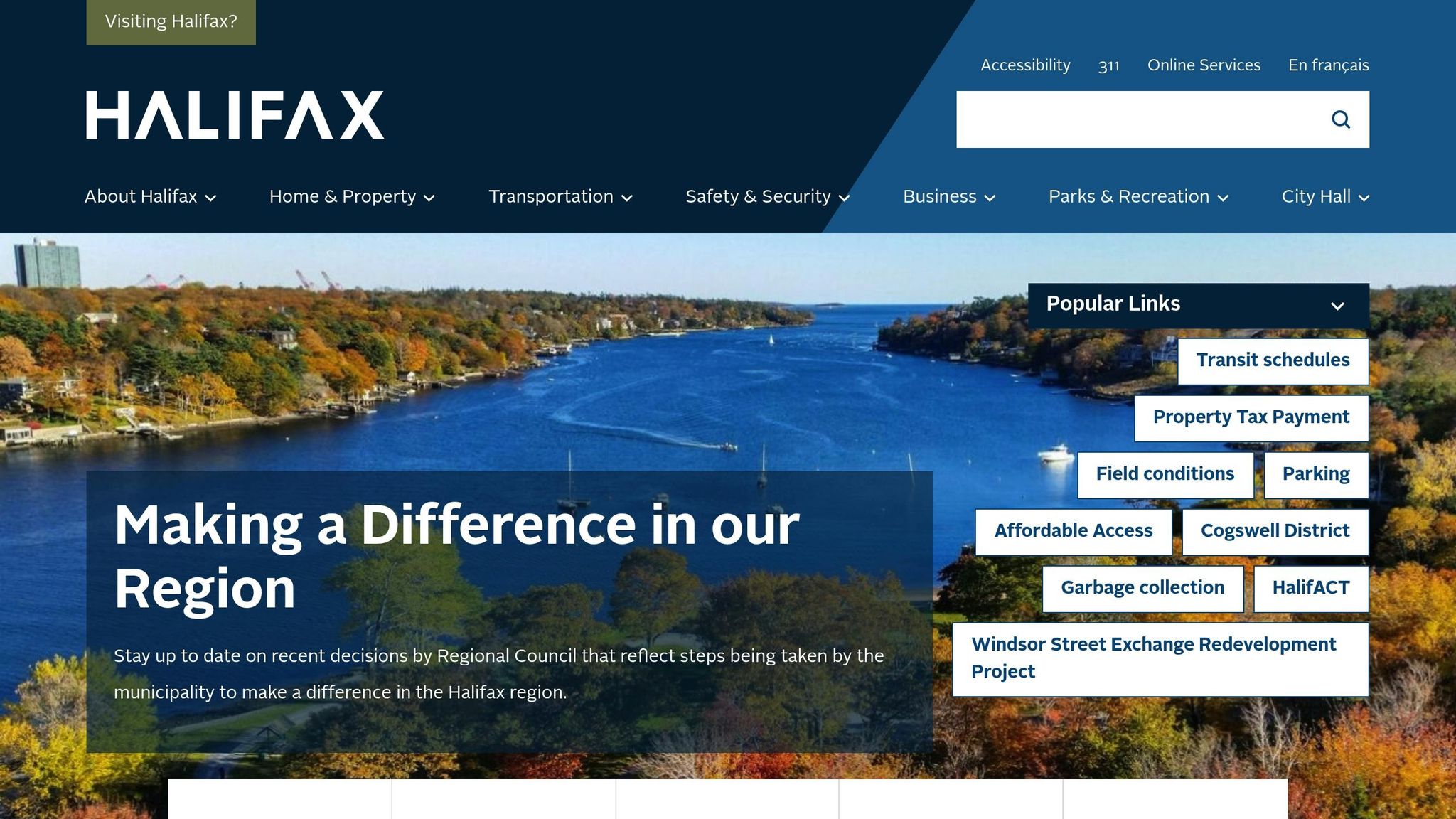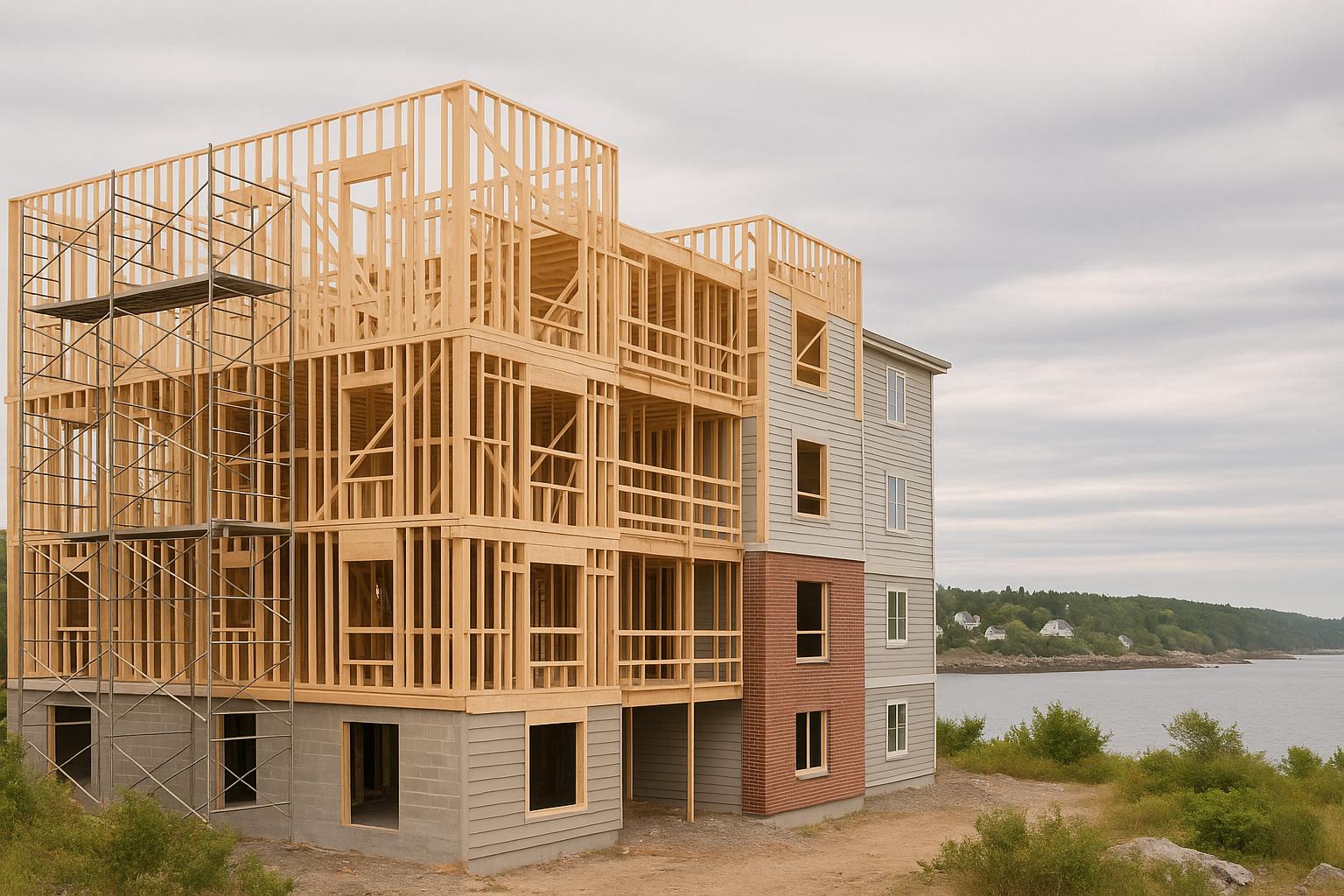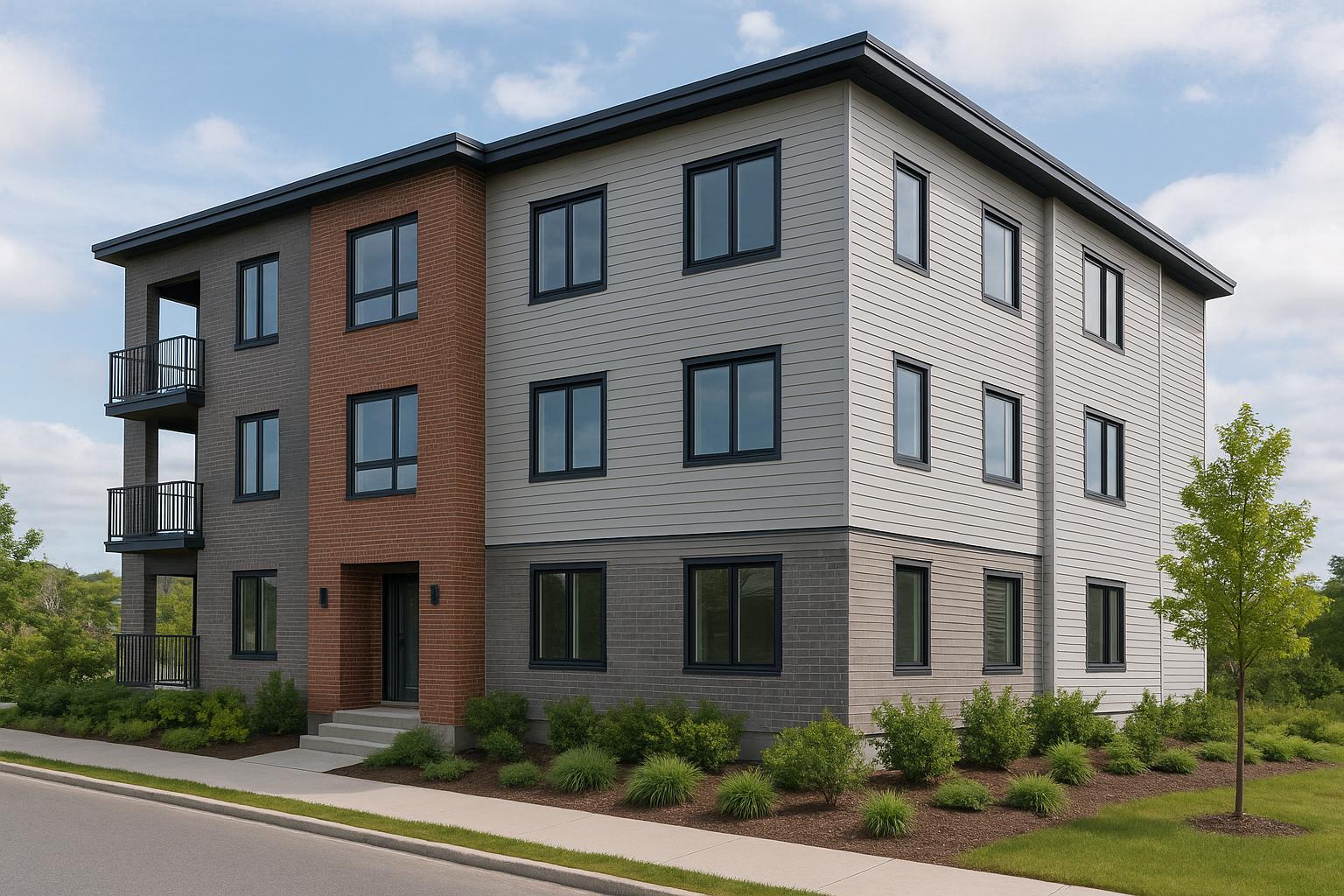Nova Scotia's housing market presents two distinct paths for multi-unit construction: urban Halifax Regional Municipality (HRM) or rural communities. Each has unique cost structures and challenges. Urban HRM offers higher rental income potential but comes with elevated land, labour, and regulatory costs. On the other hand, rural areas provide lower land and construction costs but face logistical difficulties and lower rental demand.
Key Insights:
- Urban HRM: Higher land costs, longer permit timelines (8–12 weeks), and higher construction costs (approx. $116,000 more per unit than rural areas). However, rental demand is strong, with average two-bedroom rents at $1,707 and a 2.1% vacancy rate.
- Rural Areas: Lower land costs (e.g., $65,000/acre in Annapolis Valley) and faster permit approvals (4–6 weeks). Total project costs are significantly lower, but rental demand and yields are more modest.
Quick Comparison:
| Aspect | Urban HRM | Rural Communities |
|---|---|---|
| Land Costs | High | Lower |
| Permit Processing | 8–12 weeks | 4–6 weeks |
| Construction Costs | $116,000 higher per unit | Lower baseline |
| Vacancy Rate | 2.1% | Varies, lower demand |
| Rental Income | $1,707 (2BR avg rent) | Significantly lower |
Choosing between these options depends on your priorities: upfront costs versus long-term returns. Urban HRM suits investors seeking higher rental income, while rural areas cater to those aiming to minimize initial expenses.
Pros and Cons of New Builds in Nova Scotia
1. Urban HRM (Halifax Regional Municipality)

Developing multi-unit rental properties in Halifax Regional Municipality comes with both higher costs and notable opportunities. Population growth is driving up demand, which in turn increases land prices. At the same time, proximity to job centres and local amenities boosts the value of these properties. These factors create a unique environment for urban property development.
As demand grows, the cost of developable land continues to rise. For instance, the average rent in Halifax is roughly 20% higher than in Dartmouth [1], underscoring the premium attached to living in urban areas.
On the regulatory side, Halifax has introduced zoning changes that benefit multi-unit developers. These updates now allow up to eight units on certain lots, making it possible to distribute land costs across more rental units. According to Halifax Regional Municipality:
"The most urgent priority in municipal land-use planning, regulation and development approval is to rapidly increase the supply of housing in the Municipality." [5]
Labour costs also play a significant role, accounting for 20–40% of total project expenses [2]. These costs are influenced by both high demand for skilled workers and the region's living expenses. The construction sector is facing workforce shortages, with 129,000 job openings reported as of February 2023 [3].
Municipal fees and charges further shape the budget for multi-unit projects. For example, Halifax's permit structure includes specific fees for different types of construction:
| Fee Type | Cost |
|---|---|
| Building Permit (Residential) | $4.04/sq m |
| Minimum Permit Fee | $31.25 |
| Wastewater Connection | $4,115.04/unit |
Additionally, developers must account for a Regional Development Charge of $4,115.04 per unit for wastewater connections [4]. These municipal requirements are key considerations during the planning stage.
To manage expenses, fixed-price construction at $160,000 per unit offers financial predictability. For property owners, building fourplexes or larger developments can yield monthly rents ranging from $1,950 to $2,100 per unit, translating into annual returns of 12–20%.
2. Rural Communities in Nova Scotia
Building multi-unit developments in rural areas of Nova Scotia comes with its own set of financial considerations, quite distinct from those in urban Halifax Regional Municipality (HRM). One of the biggest advantages? The cost of land. On average, rural land in Nova Scotia is priced at around $3,913 per acre[6], which establishes a much lower starting point for project budgets.
Take the Annapolis Valley, for example. Here, a one-acre parcel of land costs approximately $65,000. Add to that the construction of an 1,800 m² building, which is estimated at $302,400, along with utility connections at $18,500, and the total project cost comes to about $539,200.
While rural projects still require careful budgeting, the savings on land can significantly shift the overall expense structure. Another way to cut costs? Plan construction during the off-peak season, from October to March. Contractors are often more flexible during these slower months, potentially offering reduced rates. Combining these seasonal savings with lower land costs makes rural developments an attractive option for investors.
What’s more, the rural real estate market in Nova Scotia has remained steady. Unlike some other parts of Canada that have seen steep price increases, rural areas offer a more stable and predictable investment opportunity.
| Category | Estimated Cost |
|---|---|
| Land Purchase (1-acre in Annapolis Valley) | $65,000 |
| Main Construction (1,800 m²) | $302,400 |
| Utility Connections | $18,500 |
| Total Estimated Cost | $539,200 |
sbb-itb-16b8a48
Pros and Cons
When weighing the choice between urban HRM and rural Nova Scotia for your multi-unit construction project, each location offers its own set of benefits and challenges.
Urban HRM stands out for its strong market demand and well-established infrastructure. Recent zoning reforms have streamlined the approval process, making it easier to scale projects without navigating overly complex permits[11].
"There's a critical need for housing in Halifax, and we are doing everything in our power to make this happen." - John Lohr, Municipal Affairs Minister, Government of Nova Scotia[9]
That said, urban construction also comes with its share of hurdles. The Building Construction Price Index (BCPI) for residential buildings in Halifax increased by 5.5% in 2024, reflecting ongoing cost pressures[7]. Construction costs in HRM are approximately $116,000 higher than in rural Nova Scotia, and permits take 8–12 weeks to process, compared to just 4–6 weeks in rural areas[8].
On the other hand, rural communities present a different financial landscape. Lower construction costs and quicker permit approvals can help reduce project timelines, allowing investors to begin earning rental income sooner. These factors make rural areas particularly appealing to budget-conscious developers.
However, rural markets come with their own limitations. Rental yields and demand tend to be lower compared to Halifax, where the vacancy rate is just 2.1%[8]. While construction costs are reduced, rural areas often lack the infrastructure and essential services that urban centres provide. This can introduce additional challenges during both construction and property management phases.
| Aspect | Urban HRM | Rural Communities |
|---|---|---|
| Average Rent (2BR) | $1,707 | Significantly lower |
| Permit Processing | 8–12 weeks | 4–6 weeks |
| Construction Cost | $116,000 higher | Baseline |
| Land Costs | Premium pricing | Generally lower |
| Vacancy Rate | 2.1% | Varies, often lower demand |
| Labour Availability | Higher costs, better access | Lower costs, potential shortages |
Labour shortages also remain a persistent issue in Nova Scotia's construction sector, particularly in rural areas.
"Nova Scotia's labour force struggles affecting everything from immigration to wages to housing, this comprehensive look at the province's ICI industry is very important and much needed right now." - Duncan Williams, Construction Association of Nova Scotia[10]
Ultimately, choosing between urban HRM and rural Nova Scotia comes down to your priorities. Urban areas offer higher upfront costs but stronger rental income potential, while rural areas provide lower construction expenses but more modest returns. Using an integrated construction approach - where planners, architects, engineers, and builders collaborate under one company - can help streamline projects in either location. However, the core differences in cost and market dynamics will remain tied to your chosen setting.
Conclusion
Deciding between urban HRM and rural Nova Scotia for your multi-unit construction project comes down to weighing upfront costs against long-term returns. Urban HRM construction costs are approximately $116,000 higher per unit compared to rural areas. However, this higher initial investment is balanced by stronger rental yields, with the average rent for a two-bedroom unit sitting at $1,707 [8].
For those with substantial capital and a focus on long-term gains, urban HRM presents attractive opportunities. The city's low 2.1% vacancy rate and strong rental demand provide a steady income stream, even with elevated land and labour costs [8]. On the other hand, rural Nova Scotia may appeal to budget-conscious investors, offering lower construction costs that help keep project expenses manageable. That said, this comes with more modest rental income, requiring a careful assessment of priorities for each market.
Considering these cost dynamics, adopting an integrated design-build approach is crucial to achieving optimal results. With construction costs in Halifax rising by 8.1% between Q1 2023 and Q1 2024, a unified and fixed-price team can help streamline coordination and avoid budget overruns [12].
To manage cost uncertainties, setting aside a contingency fund of 10–20% is a smart move. Additionally, prioritize contractors who provide guaranteed timelines and include financial penalties for delays. Collaborating with professionals familiar with Nova Scotia’s construction landscape will ensure a smoother process and more predictable outcomes for your investment.
FAQs
What factors should I consider when deciding to build in urban Halifax versus rural Nova Scotia?
When deciding between building in urban Halifax or rural Nova Scotia, there are several important factors to keep in mind:
- Cost per square foot: Construction in Halifax often comes with higher expenses due to increased labour rates and stricter regulations. In contrast, rural areas typically offer lower costs.
- Land prices and preparation: Land in Halifax is generally pricier, and site preparation can be more complex. Rural locations, on the other hand, often provide more affordable land with fewer preparation requirements.
- Labour and materials: Urban builds might face higher labour charges and logistical hurdles for material delivery. In rural areas, labour costs can be lower, but finding skilled workers might take longer and cause delays.
These factors can have a big impact on your budget and timeline, so it’s essential to carefully consider the pros and cons of each location before moving forward with your project.
How do zoning changes in Halifax Regional Municipality affect the cost and viability of building multi-unit rental properties?
Zoning updates in the Halifax Regional Municipality (HRM) are reshaping the landscape for multi-unit rental developments, directly influencing both costs and project feasibility. These changes are part of an effort to tackle housing shortages by introducing measures like increased density allowances, higher building height limits in certain zones, and the reduction or removal of minimum parking requirements. By making better use of available land, these adjustments could also help bring down construction expenses.
Take the ER-3 zoning, for example. It now allows up to four units on lots that were previously restricted to single-family homes. On top of that, the permitting process has been streamlined to cut down delays and create more predictable project timelines. This is a game-changer for property owners, enabling them to plan smarter and build more efficiently - particularly when using fixed-price construction models.
How can investors manage the higher construction costs in urban areas like Halifax?
Investing in urban construction projects, especially in cities like Halifax, often comes with higher costs. However, there are ways to manage these expenses effectively. One of the most important steps is strategic planning. Start by choosing a location that strikes a balance between affordability and long-term rental demand. While urban land prices might be steeper, areas with strong tenant interest can help offset those upfront costs through higher rental income.
Another smart move is partnering with builders who use an integrated construction approach. This means having one team handle design, planning, and construction, which can help streamline the process and cut down on inefficiencies. For added cost control, consider going with a fixed-price contract. Unlike cost-plus models, this option offers more certainty and helps you avoid surprise expenses.
It's also worth staying updated on local policies. For instance, Halifax has been working on improving its permit process, which could lower administrative costs and reduce delays. By focusing on efficiency and making informed choices, investors can navigate the challenges of urban construction while boosting the potential returns on their projects.
Related Blog Posts
- Halifax & Area Development Guide: Opportunities in Underserved Communities
- Building in the North Shore: Guide to New Glasgow, Pictou & Surroundings
- ER-1/ER1, ER-2/ER2, ER-3/ER3 Cost per Square Foot: 2025 Benchmarks and What Moves Them
- Building in Rural vs. Urban Nova Scotia: How Location Impacts Your Budget



